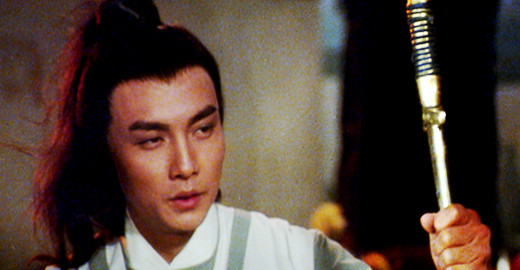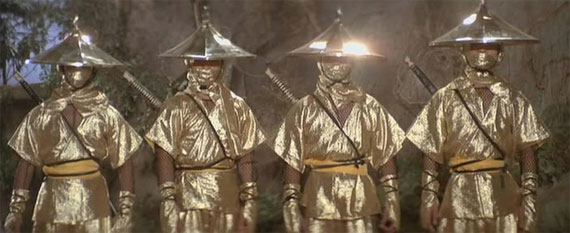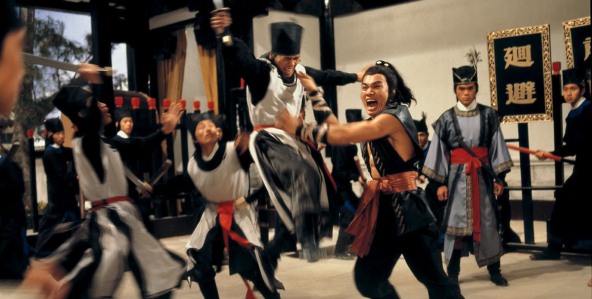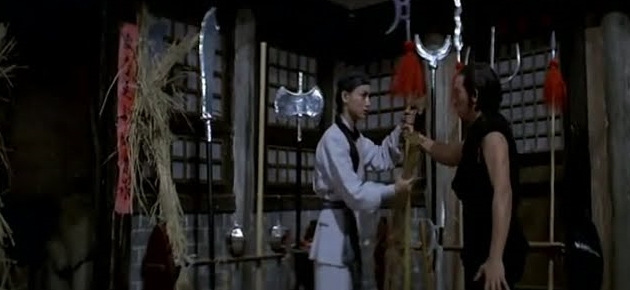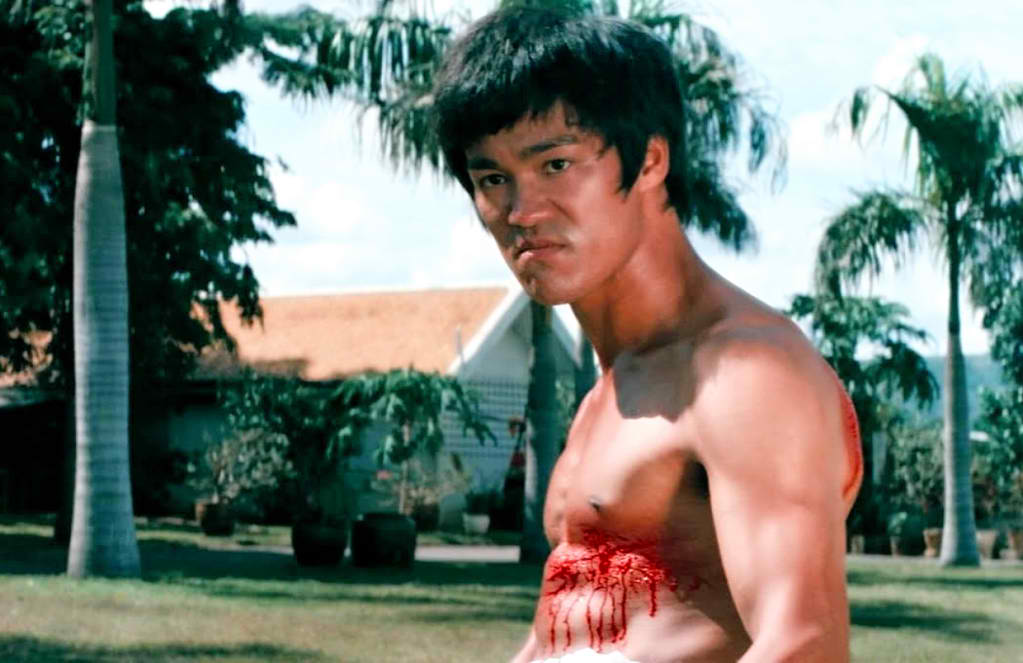6. Last Hurrah For Chivalry (1979, John Woo)
When directors work in the same genre enough, they end up tinkering with the parts enough to find the system that works best. The template John Woo found in Last Hurrah For Chivalry was, that in heroic bloodshed movies, the two male leads don’t have to be mirrors or opposites of each other. The interesting story comes from differences, not inverses.
One hero is not the -1 to the other’s +1. One is an alcoholic; the other is not a teetotaler, he just drinks when there is cause for celebration. One is a cynical guys with a seen-it-all attitude. The other is not completely wide-eyed, he just admires the other’s worldliness. This dynamic creates the stimulation lost in an Odd Couple team, where the whole point is only to see how the white cop learns to be a soul-brother like the black cop.
It’s also important that the heroes have lives and goals that only connect in the second half. They know each other only in passing for a while, so there is less strain on seeing how they interact as a team. This also holds the audience’s breath, since the movie pretends not to hinge on them learning to get along. Their friendship is forged when they plan out their Attack on The Fortress. Their differences are now immaterial; there is no “despite.”
During the Attack, their differences never play a role in how successful the mission is, which means they’re real people after all. They’re not stock characters specifically designed to “learn a little somethin’ from each other.”
Woo, in typical fashion, can film some damn good action sequences, and the ones in Chivalry are among the best he ever did. The fight in the field, in two seconds, could solve a huge issue in Hollywood right now; the slow-mo action. So, two guys fight with swords. At the end, the good guy uses his sword to knock the bad guy’s sword out of his hand.
While it’s knocked in mid-air, good guy uses two motions to serve as a final punctuation mark to the fight: his sword swipes right, knocking the mid-air sword out of play; it swipes left, to deliver the killing blow. Knock, slash. One, two. Woo presents this split-second action in slow-mo, so the audience can see what’s happening. But slow-mo offers exponentially diminishing returns, so Woo implies a quicker pace by delivering an immediate cut once the slash is delivered. One, twoCUT. That’s all there is to it.
7. Five Element Ninjas (1982, Chang Cheh)
The plot: is not important for this entry. Our heroes must train to go through five levels of ninjas to get to the final boss. The ninja’s expertise corresponds to the five atoms that comprise the universe: wood, earth, gold, fire and water.
This is a playful, if violent, movie. In the same way that the cheezy “horror” movies floating around exist solely to find creative ways of killing people, so does Five Element Ninjas, just with action. In that sense, it’s a lower-budget equivalent to the Transporter and Expendables series, specifically designed for the new filmmaker and actor to prove him/herself.
Venoms is at its best coming up with traps and styles, and exploiting their weaknesses. Like most of the other movies on the list, this does not require cash; it requires thought. If you hit a dead end coming up with ways to defeat the enemy while the hero’s ankles are shackled, make the shackles the whole fight.
An old master gave him a magic key to unlock the shackles. Who cares? The hero needs to get the final boss still, so he spends the fight getting them on the guy. Let the choreographers and actors come up with the stunts while hitting all the major plot points, and voila! You shot your action movie the way Larry David shot Curb Your Enthusiasm. It works.
8. Five Deadly Venoms (1978, Chang Cheh)
The art of the top-down concept. Five leads are hired for the next picture, but there’s no story yet. Make them all distinct by giving them distinct styles. Boy bands are memorable, because each member has a distinct label and personality. So give them a concept; say, animals with venom. Their styles look like the animals they’re named after. Give them a mask, too, so they look like superheroes. Voila.
This is better than The Avengers in every way. There is a common tie, beyond “we need you guys to save America! I mean, the world!” The Venoms were all trained by the same master. A new student needs to track them down. Some are good guys, but some have turned evil. It’s a mystery as much as it is a martial arts movie. There are always pieces in motion when the arms and legs aren’t.
Five Deadly Venoms uses the classic formula of the protagonist as outsider, learning the rules of the universe with the audience as the movie progresses. But an important difference to the traditional Hollywood vehicle is that the important bits of the journey are laid out at the get-go.
In the first five minutes, the audience knows every hero and villain’s talents, as well as the protagonist’s mission and its purpose. The mystery, then, is which ones are the heroes and villains. But it isn’t a whodunnit, because every character is already shown. The movie relies on connecting 1, 2, 3, 4 and 5 to A, B, C, D and E, not, “Out of every character we’ve seen, who’s the killer?”
The action sequences are wonderful, as is typical for a Chang Cheh kung movie. They’re the highlight of the movie. But this entry is to show that action movies don’t have to rely solely on the gimmick to be memorable. “Hulk is strong. Put him in a china shop.” Instead, action movies can be, and frequently are in kung fu, supported by gimmicks that feed into each other holistically.
The second time you watch a Jackie Chan movie, you may find yourself fast-forwarding to the best bits. This will never happen with Five Deadly Venoms, since its structure is based on people the audience cares about and are interested in. How many times have you popped in Thor since you bought it?
9. Legendary Weapons of China (1982, Lau Kar-leung)
A kung fu master who must inevitably fight his brother knows how out of practice he is. He trains, and uses his experience to his advantage. His experience helps him size up his opponents’ strengths and weaknesses, and ultimately helps him win. But his age is never the point! He is simply a man on a mission usually handled by people in their physical prime.
The focus on youth leaves out a huge narrative largely ignored by Hollywood: the story of the old master. Kung fu movies frequently used the old master as the zenith of talent, hinting at the idea that, as one gets older, they have the ability to shed earthly physical restraints.
The young are too naive to understand how, so this harnessing can only come when it’s needed the most. Hong Kong turned a weakness into the ultimate strength, and Lau gave one of the best examples in Weapons, by toying with the idea itself instead of merely presenting it.
Hollywood occasionally makes the old-guy movie. “Old people can still kick some ass,” starring old guys in space, or at a casino, or some other place where the youth are usually dominating. Some young punks decide to mouth off, but not to worry. Michael Douglas still knows a thing or two. Insert a 40 year-old woman to be the love interest for this 70 year-old man, and voila!
Erectile Dysfunction Pill Commercial: The Movie! But there has to be a better statement to be made on behalf of seniors other than, “I’m not dead yet!” Perhaps it is that seniors aren’t seniors. They’re masters who transcend the youthful physical prime.
10. The Big Boss (1971, Lo Wei)
As with Jackie, the world will only ever get the likes of Bruce again accidentally. But the people who first gave him his break in the movies did not deify him, because he was not yet a god. In Big Boss, he hardly fights at all, and plays the, “I made a promise not to fight!” role. And it’s fine, because it follows the same rules horror does.
The horror villain is not scary when he’s constantly shown, because the mystery is gone. This horror villain is really bad at being scary if he’s hanging out in the kitchen all the time. Likewise, the action star is ironically worse the more (s)he’s used. If they have to fight a lot, then they’re not doing their job well. Thus, Bruce ends the fights that other people start. He does not engage fights that last forever because of reasons not concerning the story.
The premise of kung fu is that, as evolved from swordplay movies, the protagonists now use feet and hands. It’s supposed to feel harder, faster, and more real. Fights that center on blocks and defense are referred to as “shapes” movies by kung fu fans, and the alternative to shapes are “bashers.”
Bruce is a basher, which American audiences love. Hollywood does not care one ounce about how two invented “kung fu” styles would fare against each other. Thus, Bruce vehicles are about real people in warehouses beating the crap out of each other, and how he wants to stop it as quickly as possible. That’s the tension lost to Hollywood.
“But test audiences love seeing fights!” Yeah, and they have no idea why. That’s the job of the people who make the movies. Audiences will love chocolate until they’ve been fed it so much, and so often, that it’s an addiction. They don’t love the action in superhero movies, they expect it.
Bruce could tease and entice, because the ultimate goal of his characters was to not do what the audience wanted to see, and failing at the goal. Women aren’t sexy when they’re trying to be sexy. They’re sexy when they’re trying to keep it together, and can’t.
Author Bio: Patrick works full time in childcare. He spends his free time pursuing adult hobbies, such as writing about his favorite movies.
